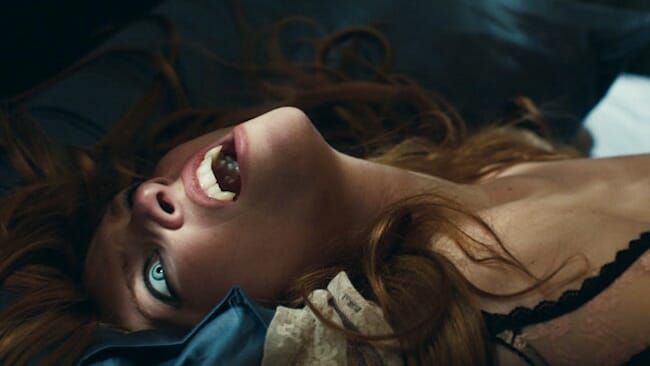
Vampires have always been associated with sex. From the sexual awakening of Lucy and Mina in Bram Stocker’s Dracula, to the homoeroticism in Interview with a Vampire, the genre has, in many ways, been more about the exploration of human desire than it has been about blood-sucking.
Twilight hijacked the genre and proposed that sensitive, millennial vampires could choose to eat animal blood, make nice with humans, and enter into monogamous relationships for all eternity. In Stephanie Meyers’ world, vampires have the ability to turn from their natural inclinations in order to fit in with Protestant America.
In Xan Cassavetes’ Kiss of the Damned, these two paradigms are pitted against each other.
Djuna (Josephine de La Baume) is a beautiful european ginger who lives in a palatial mansion by a lake. She sleeps by day and spends her nights hunting wild animals in the surrounding park lands and watching black-and-white movies. Then she meets Paolo (Milo Ventimiglia), a writer with washboard abs and a penchant for nudity. From the time they lock eyes in a seedy video store, Djuna is overwhelmed by her conflicting desires both to bone him and drain him.
The film is packaged like a love story: girl meets boy, girl debates whether to sleep with boy, to snack on boy or to turn boy into a vampire to live with forever. But this is only the beginning—the first 25 minutes. Choosing the third option, mid-coitus, Djuna transforms Paolo into a vampire like herself. Beautiful and eternally young, it seems like the two are destined for perpetual happiness.
Their fairy tale ending is derailed when Mimi (Rozane Mesquida), Djuna’s nymphomaniac sister, seeks refuge in the mansion. Mimi is dangerous, sexually insatiable, and incredible aroused by violence.
Djuna and Mimi exemplify conflicting opinions in the wider vampiric community. Djuna wants to live discreetly and has gone out of her way to accommodate humanity, just like Bella and Edward. Djuna and Paolo pledge themselves to one another which raises the question: if vampires live forever and can’t reproduce, what sense does it make to have one partner for all eternity? (It probably doesn’t, save as a Western civilization-flavored standard to which Djuna and Paolo try to adhere.)
Mimi feeds on humans. She is promiscuous, and she has been chased from one part of the globe to the other for this behavior. The struggle between these two sisters seems to represent the struggle of any minority group: assimilate or stay true to one’s cultural heritage.
This struggle is reinforced stylistically as well. Visually the film draws inspiration from classic Hammer era horror, with a dash of early 1990s late-night Cinemax smut thrown in for good measure.
By the end of the film, only one sister will have prevailed. In their struggle, Cassavetes reestablishes the vampire as both dangerous and sexy. Everything that is old is new again—a revelation I can really sink my teeth into.
Director: Xan Cassavetes
Writer: Xan Cassavetes
Starring: Joséphine de La Baume, Milo Ventimiglia, Roxane Mesquida
Release Date: May3, 2013